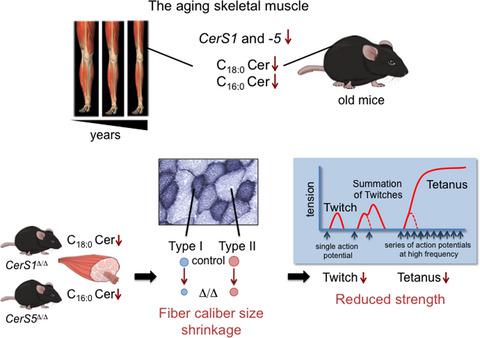当前位置:
X-MOL 学术
›
Aging Cell
›
论文详情
Our official English website, www.x-mol.net, welcomes your feedback! (Note: you will need to create a separate account there.)
A tissue-specific screen of ceramide expression in aged mice identifies ceramide synthase-1 and ceramide synthase-5 as potential regulators of fiber size and strength in skeletal muscle.
Aging Cell ( IF 7.8 ) Pub Date : 2019-11-06 , DOI: 10.1111/acel.13049 Bettina Tosetti 1, 2 , Susanne Brodesser 2 , Anna Brunn 3 , Martina Deckert 3 , Matthias Blüher 4 , Wolfram Doehner 5, 6 , Stefan D Anker 7, 8 , Daniela Wenzel 9 , Bernd Fleischmann 9 , Carola Pongratz 1, 2 , Franziska Peters 1, 2 , Olaf Utermöhlen 1, 10 , Martin Krönke 1, 2, 10
Aging Cell ( IF 7.8 ) Pub Date : 2019-11-06 , DOI: 10.1111/acel.13049 Bettina Tosetti 1, 2 , Susanne Brodesser 2 , Anna Brunn 3 , Martina Deckert 3 , Matthias Blüher 4 , Wolfram Doehner 5, 6 , Stefan D Anker 7, 8 , Daniela Wenzel 9 , Bernd Fleischmann 9 , Carola Pongratz 1, 2 , Franziska Peters 1, 2 , Olaf Utermöhlen 1, 10 , Martin Krönke 1, 2, 10
Affiliation

|
Loss of skeletal muscle mass is one of the most widespread and deleterious processes in aging humans. However, the mechanistic metabolic principles remain poorly understood. In the framework of a multi‐organ investigation of age‐associated changes of ceramide species, a unique and distinctive change pattern of C16:0 and C18:0 ceramide species was detected in aged skeletal muscle. Consistently, the expression of CerS1 and CerS5 mRNA, encoding the ceramide synthases (CerS) with substrate preference for C16:0 and C18:0 acyl chains, respectively, was down‐regulated in skeletal muscle of aged mice. Similarly, an age‐dependent decline of both CerS1 and CerS5 mRNA expression was observed in skeletal muscle biopsies of humans. Moreover, CerS1 and CerS5 mRNA expression was also reduced in muscle biopsies from patients in advanced stage of chronic heart failure (CHF) suffering from muscle wasting and frailty. The possible impact of CerS1 and CerS5 on muscle function was addressed by reversed genetic analysis using CerS1Δ/Δ and CerS5Δ/Δ knockout mice. Skeletal muscle from mice deficient of either CerS1 or CerS5 showed reduced caliber sizes of both slow (type 1) and fast (type 2) muscle fibers, fiber grouping, and fiber switch to type 1 fibers. Moreover, CerS1‐ and CerS5‐deficient mice exhibited reduced twitch and tetanus forces of musculus extensor digitorum longus. The findings of this study link CerS1 and CerS5 to histopathological changes and functional impairment of skeletal muscle in mice that might also play a functional role for the aging skeletal muscle and for age‐related muscle wasting disorders in humans.
中文翻译:

老年小鼠中神经酰胺表达的组织特异性筛选将神经酰胺合酶1和神经酰胺合酶5确定为骨骼肌纤维大小和强度的潜在调节剂。
骨骼肌质量的丧失是衰老人类中最普遍和最有害的过程之一。然而,机械代谢原理仍然知之甚少。在对与年龄相关的神经酰胺物质变化进行多器官研究的框架下,在老年骨骼肌中检测到了C 16:0和C 18:0神经酰胺物质的独特而独特的变化模式。一致地,在衰老小鼠的骨骼肌中,编码神经酰胺合酶(CerS)的CerS1和CerS5 mRNA的表达分别下调了C 16:0和C 18:0酰基链的底物。同样,CerS1和CerS1的年龄依赖性下降在人的骨骼肌活检中观察到CerS5 mRNA表达。此外,在患有肌肉萎缩和虚弱的慢性心力衰竭(CHF)晚期患者的肌肉活检中,CerS1和CerS5 mRNA的表达也降低了。CerS1和CerS 5对肌肉功能的可能影响通过使用CerS1Δ /Δ和CerS5Δ /Δ敲除小鼠的反向遗传分析解决。缺乏CerS1或CerS5的小鼠的骨骼肌显示出慢速(1型)和快速(2型)肌纤维的口径减小,纤维分组,并且纤维转换为1型纤维。此外,CerS1缺陷小鼠和CerS5缺陷小鼠的趾长肌伸肌的抽搐和破伤风力降低。这项研究的发现将CerS1和CerS5与小鼠的组织病理学变化和骨骼肌功能受损联系起来,这可能也对衰老的骨骼肌和人类衰老相关的肌肉消耗失调起了一定的作用。
更新日期:2019-11-06
中文翻译:

老年小鼠中神经酰胺表达的组织特异性筛选将神经酰胺合酶1和神经酰胺合酶5确定为骨骼肌纤维大小和强度的潜在调节剂。
骨骼肌质量的丧失是衰老人类中最普遍和最有害的过程之一。然而,机械代谢原理仍然知之甚少。在对与年龄相关的神经酰胺物质变化进行多器官研究的框架下,在老年骨骼肌中检测到了C 16:0和C 18:0神经酰胺物质的独特而独特的变化模式。一致地,在衰老小鼠的骨骼肌中,编码神经酰胺合酶(CerS)的CerS1和CerS5 mRNA的表达分别下调了C 16:0和C 18:0酰基链的底物。同样,CerS1和CerS1的年龄依赖性下降在人的骨骼肌活检中观察到CerS5 mRNA表达。此外,在患有肌肉萎缩和虚弱的慢性心力衰竭(CHF)晚期患者的肌肉活检中,CerS1和CerS5 mRNA的表达也降低了。CerS1和CerS 5对肌肉功能的可能影响通过使用CerS1Δ /Δ和CerS5Δ /Δ敲除小鼠的反向遗传分析解决。缺乏CerS1或CerS5的小鼠的骨骼肌显示出慢速(1型)和快速(2型)肌纤维的口径减小,纤维分组,并且纤维转换为1型纤维。此外,CerS1缺陷小鼠和CerS5缺陷小鼠的趾长肌伸肌的抽搐和破伤风力降低。这项研究的发现将CerS1和CerS5与小鼠的组织病理学变化和骨骼肌功能受损联系起来,这可能也对衰老的骨骼肌和人类衰老相关的肌肉消耗失调起了一定的作用。



























 京公网安备 11010802027423号
京公网安备 11010802027423号